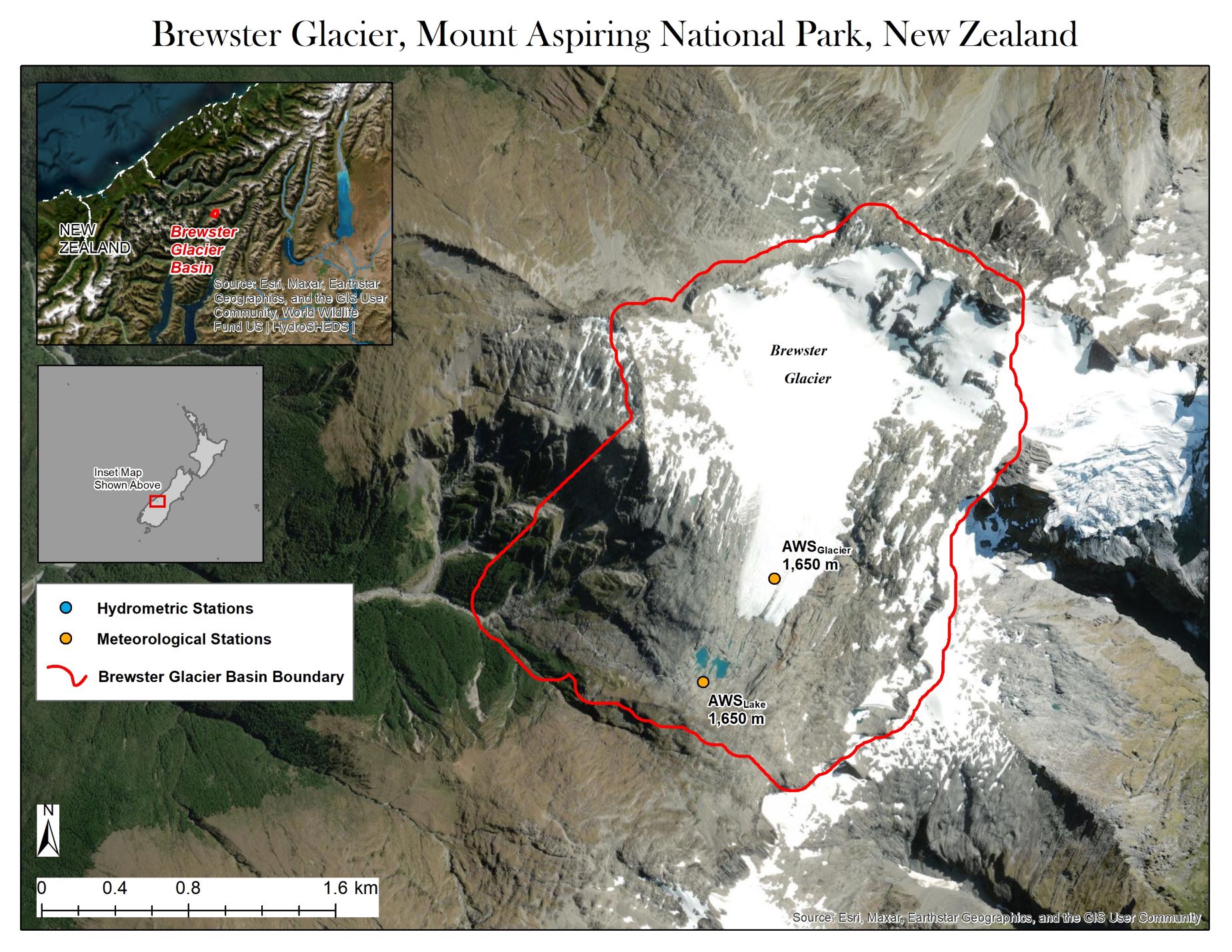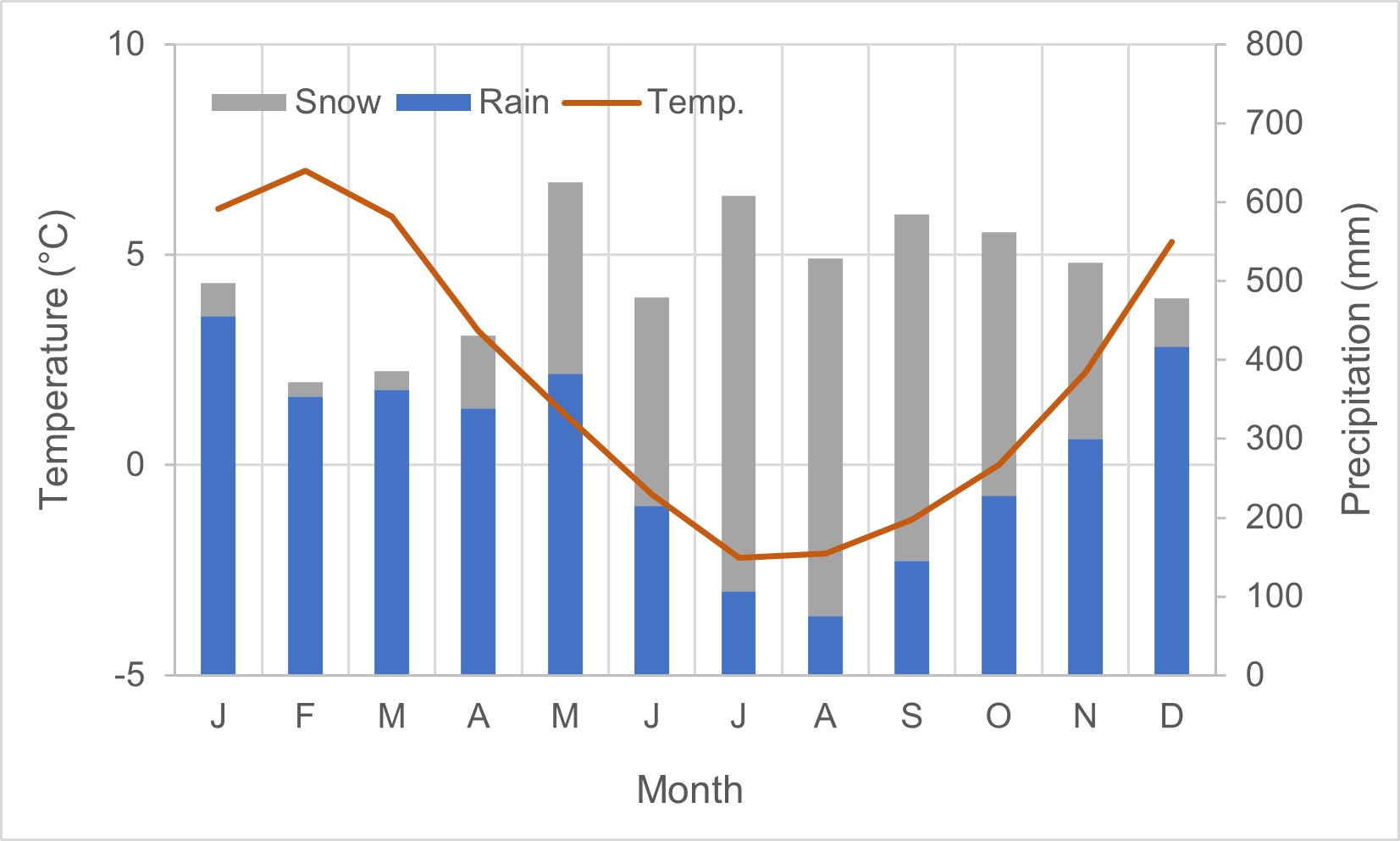Overview

- Location: Mount Aspiring National Park, New Zealand; 44.08°S, 169.43°E
- Operational Management: School of Geography, University of Otago
- Access: Brewster Glacier and its surrounding basin is close to Haast Pass. Access is possible by foot from Fantail Falls (Haast River) via Brewster Hut. Helicopter access by concession only (issued by Department of Conservation).
- Purpose/Scientific Focus: In 2004, a mass balance programme was initiated by the University of Otago and Victoria University on Brewster Glacier, which has continued to present with the support of the National Institute of Water and Atmospheric Research (NIWA), making it the longest mass balance record in the Southern Alps. The winter, summer and annual mass balance data are provided to the World Glacier Monitoring Service (WGMS) and have been used to validate mass balance modelling and remote sensing observations. An automatic weather station was installed on bedrock near the terminus of the glacier when the mass balance was initiated. It was upgraded with high quality radiation instruments in 2010, which have been important for advancing knowledge on the role cloud forcing plays in controlling the variability of seasonal snow and glacier mass balance. Short term meteorological observations, including eddy covariance measurements, have also been obtained in the ablation zone of Brewster Glacier. The meteorological observations obtained on and next to Brewster Glacier have provided a foundation for research to improve the understanding of mountain climate in the Southern Alps, and more broadly, the Southern Hemisphere.
Characteristics

- Location (Physiographic Region): Brewster Glacier is a small maritime alpine glacier, located west of the Main Divide of the Southern Alps in the Mount Aspiring National Park, New Zealand. The primary bedrock is schist, metamorphosed from sediments and volcanics during the late Mesozoic.
- Area: The area of Brewster Glacier in 2011 was 2.03 km2, with the glacier extent covering approximately 70% of the glacier basin.
- Elevation: Brewster Glacier extends over an elevational range between 1706 and 2389 m a.s.l. The upper section of the glacier has a mean slope of 31° and southwesterly aspect, while the lower areas have a gentler slope (mean slope of 10°) with a southerly aspect.
- Description (Physical–Ecological–Climatic Characteristics): Brewster Glacier is situated in an alpine glacier setting just west of the Main Divide of the Southern Alps. The mean and minimum elevation of Brewster Glacier are similar to the majority of glaciers in the Southern Alps. By virtue of its position close to the Main Divide near the midpoint of the north-south distribution of glaciers in the Southern Alps, moderate elevation and high exposure to synoptic weather systems, observations from Brewster Glacier have been shown to be representative of the regional atmospheric controls on glacier surface climate. The climate of the Southern Alps is generally considered to be characteristic of a temperate, maritime setting. The Southern Alps are surrounded by ocean and their mid-latitude location means they are strongly influenced by both subtropical and polar air masses.
- Drainage/River System: The tributaries from Brewster Glacier feed into the Haast River, which drains into the Tasman Sea on the West Coast of the South Island, New Zealand.
- Site History/Historical Context: Initiated as a long-term inter-disciplinary research project in 2004/5. The 10-year data meteorological data set is described here: https://doi.org/10.1002/joc.7323
- Glacierized Area (% and year(s) measured): 2.03 km2; Quick-bird image on 8 February 2011.
- Main Land Cover(s): The primary bedrock is schist, metamorphosed from sediments and volcanics during the late Mesozoic.
- Lithology/Soils: The primary bedrock is schist.
- Mean Annual Temperature: 2.1°C
- Mean Total Annual Precipitation: 6,074 mm
- Snow Characteristics: Seasonal snow, with dry snowfall in winter that is often redistributed due to wind and blowing snow. Melt events in winter can occur. Snow and some hoarfrost can temporally build up on sensors in midwinter. Peak snow accumulation is in late October, and is at a minimum at the end of April.
- Years of Data: Mass balance: 2005-present; Meteorological observations: 2010-present
Stations & Observations
Observational Stations and Sites
| Type | Station Name | Latitude | Longitude | Elevation | Notes/Details |
| Meteorological | AWSLake | 44.084° S | 169.429° E | 1650 m | A long-term meteorological record near the terminus of Brewster Glacier (2010-present). |
| Meteorological | AWSGlacier | 44.079° S | 169.434° E | 1760 m | A 22-month meteorological record in the ablation zone of Brewster Glacier. |
Field Observation Campaigns and Other Measurements
| Measurement | Instrument Description | Spatial/Temporal Resolution and Coverage | Notes/Details |
| Snow Pits/Snow Surveys | Manual snow density measurements | 1-2 snow pits at the end of winter. | Snow density observations available on request. |
| Glacier Mass Balance | Stake and probing observations of summer, winter and annual mass balance | End of winter and summer observations | Data submitted to the World Glacier Monitoring Service (WGMS)and description of mass balance given in Cullen et al. (2017). |
Data Availability
Geospatial Data
| Elevation | Digital elevation model (DEM) with 15 m resolution (NZSoSDEM) - described by Columbus et al. (2011) and available from: https://koordinates.com/ |
| Landcover and Soils | Data are available on request. |
| Stream/River Network | Data are available on request. |
| Basin Delineation/Shapefile | Data are available on request. |
Observational Data Availability
- Abrahim, B. N., Cullen, N. J., & Conway, J. P. (2022). A decade of surface meteorology and radiation exchanges at Brewster Glacier in the Southern Alps of New Zealand. International Journal of Climatology, 4(2), 1612-1631. doi: 10.1002/joc.7323. Data available on request: nicolas.cullen@otago.ac.nz
- Cullen, N. J., & Conway, J. P. (2015). A 22 month record of surface meteorology and energy balance from the ablation zone of Brewster Glacier, New Zealand. Journal of Glaciology, 61(229), 931-946. doi: 10.3189/2015JoG15J004. Data available here: https://zenodo.org/record/2559553
- Cullen, N. J., Anderson, B., Sirguey, P., Stumm, D., Mackintosh, A., Conway, J. P., … Fitzsimons, S. J., & Lorrey, A. (2017). An 11-year record of mass balance of Brewster Glacier, New Zealand, determined using a geostatistical approach. Journal of Glaciology, 63(238), 199-217. doi: 10.1017/jog.2016.128
Modelling Activities
- Abrahim, B. N., Cullen, N. J., Conway, J. P., & Sirguey, P. (2023). Applying a distributed mass-balance model to identify uncertainties in glaciological mass balance on Brewster Glacier, New Zealand. Journal of Glaciology, 69(276), 1030-1046. https://doi.org/10.1017/jog.2022.123
- Abrahim, B. N., Cullen, N. J., & Conway, J. P. (2022). A decade of surface meteorology and radiation exchanges at Brewster Glacier in the Southern Alps of New Zealand. International Journal of Climatology, 4(2), 1612-1631. https://doi.org/10.1002/joc.7323
- Conway, J. P., Abermann, J., Andreassen, L. M., Azam, M. F., Cullen, N. J., Fitzpatrick, N., … Sicart, J.-E. (2022). Cloud forcing of surface energy balance from in situ measurements in diverse mountain glacier environments. Cryosphere, 16, 3331-3356. https://doi.org/10.5194/tc-16-3331-2022
- Lorrey, A. M., Vargo, L., Purdie, H., Anderson, B., Cullen, N. J., Sirguey, P., … Chinn, W. (2022). Southern Alps equilibrium line altitudes: Four decades of observations show coherent glacier-climate responses and a rising snowline trend. Journal of Glaciology, 68(272), 1127-1140. https://doi.org/10.1017/jog.2022.27
- Kropač, E., Mölg, T., Cullen, N. J., Collier, E., Pickler, C., & Turton, J. V. (2021). A detailed, multi-scale assessment of an atmospheric river event and its impact of extreme glacier melt in the Southern Alps of New Zealand. Journal of Geophysical Research: Atmospheres, 126, e2020JD034217. https://doi.org/10.1029/2020JD034217
- Cullen, N. J., Gibson, P. B., Mölg, T., Conway, J. P., Sirguey, P., & Kingston, D. G. (2019). The influence of weather systems in controlling mass balance in the Southern Alps of New Zealand. Journal of Geophysical Research: Atmospheres, 124, 4514-4529. https://doi.org/10.1029/2018JD030052
- Little, K., Kingston, D. G., Cullen, N. J., & Gibson, P. B. (2019). The role of atmospheric rivers for extreme ablation and snowfall events in the Southern Alps of New Zealand. Geophysical Research Letters, 46, 2761-2771. https://doi.org/10.1029/2018GL081669
- Cullen, N. J., Anderson, B., Sirguey, P., Stumm, D., Mackintosh, A., Conway, J. P., … Fitzsimons, S. J., & Lorrey, A. (2017). An 11-year record of mass balance of Brewster Glacier, New Zealand, determined using a geostatistical approach. Journal of Glaciology, 63(238), 199-217. https://doi.org/10.1017/jog.2016.128
- Hofer, M., Nemec, J., Cullen, N. J., & Weber, M. (2017). Evaluating predictor strategies for regression-based downscaling with a focus on glacierized mountain environments. Journal of Applied Meteorology & Climatology, 56(6), 1707-1729. https://doi.org/10.1175/JAMC-D-16-0215.1
- Wu, X., Davie-Martin, C. L., Steinlin, C., Hageman, K. J., Cullen, N. J., & Bodgal, C. (2017). Understanding and predicting the fate of semivolatile organic pesticides in a glacier-fed lake using a multimedia chemical fate model. Environmental Science & Technology, 51(20), 11752-11760. https://doi.org/10.1021/acs.est.7b03483
- Conway, J. P., & Cullen, N. J. (2016). Cloud effects on surface energy and mass balance in the ablation area of Brewster Glacier, New Zealand. Cryosphere, 10(1), 313-328. https://doi.org/10.5194/tc-10-313-2016
- Sirguey, P., Still, H., Cullen, N. J., Dumont, M., Arnaud, Y., & Conway, J. P. (2016). Reconstructing the mass balance of Brewster Glacier, New Zealand, using MODIS-derived glacier-wide albedo. Cryosphere, 10, 2465-2484. https://doi.org/10.5194/tc-2016-98
- Conway, J. P., Cullen, N. J., Spronken-Smith, R. A., & Fitzsimons, S. J. (2015). All-sky radiation over a glacier surface in the Southern Alps of New Zealand: Characterizing cloud effects on incoming shortwave, longwave and net radiation. International Journal of Climatology, 35(5), 699-713. https://doi.org/10.1002/joc.4014
- Cullen, N. J., & Conway, J. P. (2015). A 22 month record of surface meteorology and energy balance from the ablation zone of Brewster Glacier, New Zealand. Journal of Glaciology, 61(229), 931-946. https://doi.org/10.3189/2015JoG15J004
- Conway, J. P., & Cullen, N. J. (2013). Constraining turbulent heat flux parameterization over a temperate maritime glacier in New Zealand. Annals of Glaciology, 54(63), 41-51. https://doi.org/10.3189/2013AoG63A604
- Gillett, S., & Cullen, N. J. (2011). Atmospheric controls on summer ablation over Brewster Glacier, New Zealand. International Journal of Climatology, 31, 2033-2048. https://doi.org/10.1002/joc.2216
Contact & Further Information
Contacts
|
Name |
Role |
Contact Information |
|
Dr. Nicolas Cullen |
Professor, School of Geography, University of Otago |
Email: nicolas.cullen@otago.ac.nz Phone: +64-3-479-3069 |
|
Dr. Jono Conway |
Hydrological Forecasting Scientist, National Institute of Water and Atmospheric Research |
Email: jono.conway@niwa.co.nz Phone: +64-3-440-0409 |
|
Dr. Todd Redpath |
Lecturer, School of Geography, University of Otago |
Email: todd.redpath@otago.ac.nz |

